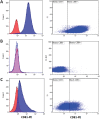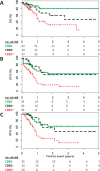Tetraspanin CD81 is an adverse prognostic marker in acute myeloid leukemia
- PMID: 27566555
- PMCID: PMC5308734
- DOI: 10.18632/oncotarget.11481
Tetraspanin CD81 is an adverse prognostic marker in acute myeloid leukemia
Abstract
CD81 is a cell surface protein which belongs to the tetraspanin family. While in multiple myeloma its expression on plasma cells is associated with worse prognosis, this has not yet been explored in acute myeloid leukemia (AML). We measured membrane expression of CD81 on AML cells at diagnosis, evaluated its association with AML characteristics and its influence on patient outcome after intensive chemotherapy in a cohort of 134 patients. CD81 was detected in 92/134 (69%) patients. Patients with AML expressing CD81 had elevated leukocyte count (P=0.02) and were more likely classified as intermediate or adverse-risk by cytogenetics (P<0.001). CD81 expression had a negative impact on survival (event-free survival, overall survival and relapse-free survival) in univariate (P<0.001) and in multivariate analyses (P=0.003, 0.002 and <0.001, respectively). CD81 has a negative impact on OS in patients with NPM1 mutation (P=0.01) and in patients ELN-favorable (P=0.002). In conclusion, this cell surface marker may be a new prognostic marker for diagnostic risk classification and a potential therapeutic target for drug development in AML.
Keywords: CD81; acute myeloid leukemia; flow cytometry; prognosis; tetraspanin.
Conflict of interest statement
The authors declare no conflicts of interest
Figures




References
-
- Levy S. Function of the tetraspanin molecule CD81 in B and T cells. Immunol Res. 2014;58:179–185. - PubMed
-
- Mattila PK, Feest C, Depoil D, Treanor B, Montaner B, Otipoby KL, Carter R, Justement LB, Bruckbauer A, Batista FD. The actin and tetraspanin networks organize receptor nanoclusters to regulate B cell receptor-mediated signaling. Immunity. 2013;38:461–474. - PubMed
-
- Mittelbrunn M, Yanez-Mo M, Sancho D, Ursa A, Sanchez-Madrid F. Cutting edge: dynamic redistribution of tetraspanin CD81 at the central zone of the immune synapse in both T lymphocytes and APC. J Immunol. 2002;169:6691–6695. - PubMed
-
- Charrin S, le Naour F, Silvie O, Milhiet PE, Boucheix C, Rubinstein E. Lateral organization of membrane proteins: tetraspanins spin their web. Biochem J. 2009;420:133–154. - PubMed
MeSH terms
Substances
LinkOut - more resources
Full Text Sources
Other Literature Sources
Medical

